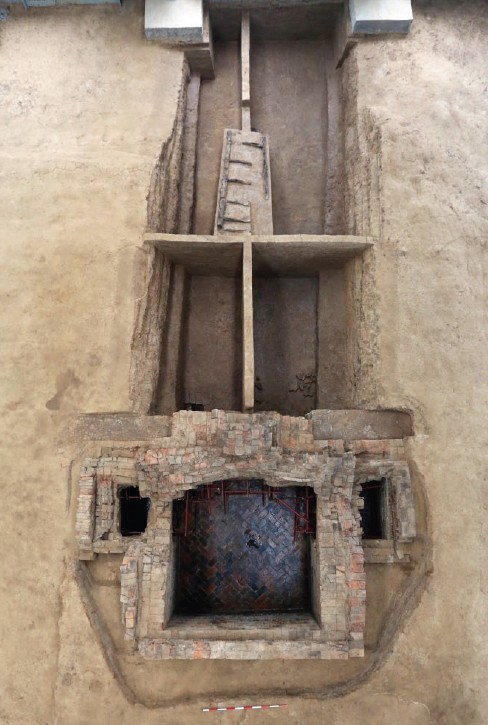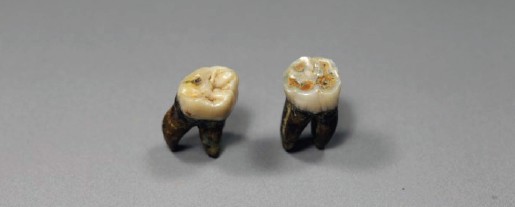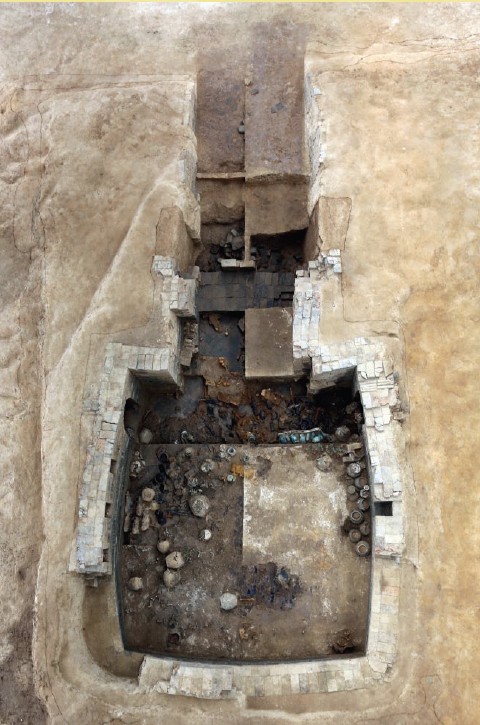Tombs of Emperor Yang and his Queen of Sui Dynasty unearthed in Yangzhou
From:Chinese Archaeology NetWriter:Date:2014-01-28
March 2013, two brick-chamber tombs have been discovered while Situ Village (Xihu prefecture, Yangzhou city) carried out a construction project. With the epitaph of “the late Emperor Yang of Sui dynasty (Sui Gu YangDi)” having been unearthed from M1 in Mid-April, SACH (State Administration of Cultural Heritage) called for a conference composed of related experts to estimate the nature of the tombs. Later, Nanjing Museum, Institute of Archaeology of Yangzhou and Institute of Archaeology of Suzhou have joined forces, forming an archaeological team to explore the site.

tomb M1
Based on the results of the primary and special investigations of the region, the team mainly applied trial trenches and in some cases excavation units to seek traces of mausoleum. So far, however, there has been no sign of mausoleum wall, spirit road, ditches, or any other indicators of a mausoleum. Neither has there been found any tomb contemporary to M1 and M2.
The mound enclosing the joint tombs is 49 meter long (west-east) and 48-meter wide. On top of the raw earth is firstly laid a layer of pure, fine white-grey earth—with a width between 0.1 and 0.3 meter—to make a flatter bottom. Above it is the mound made of rammed earth which is further composed of yellow clay with white-grey earth; densely built, the rammed earth is about 0.05- to 0.15-meter thick, flat and straight. The heap earth over the rammed earth has been damaged in a later period, making its condition rather uncertain. The constructing order of M1 would be first digging shallow pits into raw earth, and then building brick chamber while heaping rammed earth, with spaces for the passageway left unfilled. M1 is located in the center of the mound; the construction of the burial chamber is concurrent to that of the mound. M2, however, is located in the southeastern corner of the mound. Judging from the breaking relation between M2 and the mound, M2 was constructed after the mound had been reopened first, so it was built in a later period than M1.

teeth from tomb M1
M1 is composed of tomb passage, vaulted passage, eastern and western side chambers, and major burial chamber. Breaking into the raw earth, the passageway is 19.5 meter long, 5.9 to 6.42 meter wide, and 2 meter high. With the roof gone, the main burial chamber is 3.92 meter wide (north-south), 4.88 meter long (east-west), and 2.76 meter high. The bricks in M1 are identical to those used in the imperial palace in Jiangdu of Sui dynasty. Two teeth are excavated from the site; they belong to an individual about 50 years old.

a “diexie”-belt with 13 rings made of jade and gold from tomb M1
M1 also produces an epitaph, together with nearly 200 pieces of antiques, including jadeware, bronzeware and lacquerware. Among them, a “diexie”-belt with 13 rings made of jade and gold is the most precious; and is the first and only intact belt of this kind in China. Four gilded bronze door knockers are of the same size as those unearthed from the Daming Palace in Tang Dynasty; the beast head on the knocker is 0.26-meter in diameter. Judging from the “epitaph for the late Emperor Yang of Sui dynasty” and its high-level burial goods, and based on written resources and osteological results, it is confirmed that M1 belongs to no other than the Emperor Yang of Sui dynasty himself.

tomb M2
M2 is composed of tomb passage, vaulted passage, eastern and western side chambers, and major burial chamber. The entire tomb is 13.67 meter long, 5.9 meter wide; and what remains of the wall is 1.6 meter in height. The passageway is constructed in a particular way, walled with bricks, similar to the structure of shaft of tomb passage in contemporary tombs in northern areas. The burial chamber is 5.97 meter long; in the main burial chamber, a niche is carved into each of the eastern, western and northern wall. The team has found a few bricks with dragon and lotus patterns buried in the fallen earth. After examination, the human bones and teeth inside the tomb are thought to belong to an elderly woman who was aged over 56 and about 1.5 meter tall.

pottery figurine of snake with two human heads from tomb M2
M2 is rich in grave goods. So far the team has cleared over 200 pieces, including pottery, porcelain ware, bronze ware, lacquer ware, ironware and jade ware. Among the pottery, there are gray-clay pots, bowls (“bo”) and mould of stoves, lamps, mills, and benches (“ji”); and grey-clay figurines in shapes of cow, horse, pig, cock, camel, snake with two human heads, warrior with shield and script. Among the bronzeware there are a 16-piece set of chimes of bells (“bianzhong”), a 20-piece set of stone chimes (“bianqing”), a set of phoenix coronet, 10 pieces of lamps and beads; the sets of chime bells and stone chimes (“bianqing”) are the first of them from Sui-Tang period excavated in China. M2 also produces a “piyong”-shaped inkstone made of green-grazed porcelain and a jade “zhang”.

“piyong”-shaped inkstone made of green-grazed porcelain from tomb M2
Based on written resources and osteological results, the high-standard antiques uncovered from M2 yield its ownership: the Empress Xiao, queen of Emperor Yang of Sui dynasty.
Through scientifically conducted archaeological excavation, it is confirmed that the tombs in Cao village, Yangzhou belong to Emperor Yang and Empress Xiao of Sui dynasty, which corroborates written resources. The joint tombs offer material resources to the formation of advanced tombs in Sui and Tang periods; the high-standard burial goods from the tombs are extremely valuable to the study of history, politics, economy, and cultural in the historical periods in question. The excavation of the tomb of Emperor Yang of Sui dynasty does not only enrich Yangzhou’s heritage, but also helps to improve preservation and study of historical sites in the city. (Translator: Su Minjie)

